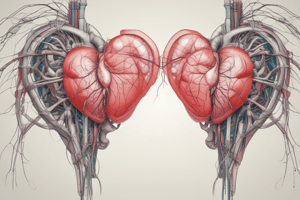Podcast
Questions and Answers
What is the primary role of the sinoatrial (SA) node in cardiac conduction?
What is the primary role of the sinoatrial (SA) node in cardiac conduction?
- To generate nerve impulses that coordinate heart contractions (correct)
- To delay impulses allowing atria to contract
- To regulate blood pressure
- To contract the ventricles
Where is the atrioventricular (AV) node located?
Where is the atrioventricular (AV) node located?
- At the base of the heart
- In the left ventricle
- Upper wall of the left atrium
- Right side near the bottom of the right atrium (correct)
Which of the following statements about arteries is correct?
Which of the following statements about arteries is correct?
- Arteries are lined with nervous tissue
- Arteries have thick muscular layers to pump blood around the body (correct)
- Arteries appear to only have a tunica intima
- Arteries have thin walls and large lumens
What is the function of the Purkinje fibers in the heart?
What is the function of the Purkinje fibers in the heart?
Which layer of the blood vessel is directly exposed to blood?
Which layer of the blood vessel is directly exposed to blood?
What happens when the impulses generated by the SA node reach the AV node?
What happens when the impulses generated by the SA node reach the AV node?
Which type of blood vessel has the largest lumen in comparison to its muscular layer?
Which type of blood vessel has the largest lumen in comparison to its muscular layer?
What type of tissue composes the SA node?
What type of tissue composes the SA node?
What is the major function of the tunica intima in blood vessels?
What is the major function of the tunica intima in blood vessels?
What occurs at the base of the atrioventricular bundles in the heart?
What occurs at the base of the atrioventricular bundles in the heart?
Flashcards are hidden until you start studying
Study Notes
Cardiac Conduction
- Cardiac muscle cells contract spontaneously and are coordinated by the sinoatrial (SA) node.
- The SA node is composed of nodal tissue with characteristics of both muscle and nervous tissue and is located in the upper wall of the right atrium.
- When the SA node contracts, it generates nerve impulses that travel throughout the heart wall, causing the atria to contract.
- The atrioventricular (AV) node delays the impulses for some seconds, allowing the atria to contract and empty their content of blood.
- The impulses are then sent down the atrioventricular bundle, which branches off into two bundles, and carried down to the center of the heart and then to the left and right ventricles.
- At the base of the heart, the atrioventricular bundles start to divide further into Purkinje fibers, triggering the muscle fibers in the ventricles to contract.
Blood Vessels
- There are three main types of blood vessels: arteries, veins, and capillaries.
- All blood vessels have three layers: tunica intima, tunica media, and tunica adventitia.
- The endothelium, a thin layer of simple squamous epithelium, lines the blood vessels, keeping blood cells inside and preventing clots from forming.
Characteristics of Blood Vessels
- Capillaries are very small, with thin walls, and often appear to have only a tunica intima.
- Arteries have the thickest muscular layers to pump blood around the body.
- Veins have very little muscle in their walls and tend to have the largest lumens.
Layers of Vascular Wall
Tunica Intima
- Lines the blood vessel and is exposed to blood
- Composed of endothelium - simple squamous epithelium overlying a basement membrane and a sparse layer of loose connective tissue.
Studying That Suits You
Use AI to generate personalized quizzes and flashcards to suit your learning preferences.




